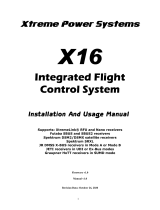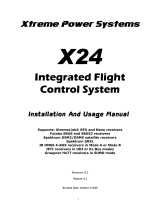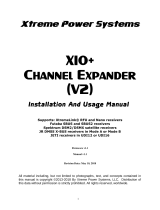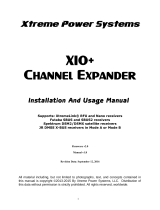
Spektrum Remote Receiver Interfacing
Page 3 Rev P3
support DSMX. For this reason, we recommend that 11ms DSMX be used (9 (“internal”) or 10
(“external”) pulses).
DSMX Bind Modes:
Pulses Mode Protocol Type
7 Internal DSMx 22ms
8 External DSMx 22ms
9 Internal DSMx 11ms
10 External DSMx 11ms
DSM2 Bind Modes (not recommended):
Pulses Mode Protocol Type
3 Internal DSM2 22ms
4 External DSM2 22ms
5 Internal DSM2 11ms
6 External DSM2 11ms
7.3 Internal and External Modes
In the Spektrum system, receivers bind as either a master (the “A” receiver) or auxiliary (the B, R, and
L receivers). In most receivers the A is internal to the receiver body, hence the “internal” moniker. The
important detail is that the A remote controls the bind process for the entire system, in that it is the only
remote which negotiates with the transmitter to establish a link. For that reason, it is absolutely
imperative that only one remote in your system be the “internal” or “A” remote. You may bind as
many other receivers as desired at the same time, but they must all be bound in the “external” mode.
All remotes must be in bind mode for them to bind to the transmitter. Any remote not in bind mode
will not bind.
If no remote is put into the internal mode, the transmitter will report Bind Failed and a link will not be
established. If multiple remotes are in internal mode, the results cannot be predicted.
When a remote is put into bind mode, it retains its previously bound information until the bind is
complete, at which time it saves the new bind information. For this reason, if you put a remote into
bind mode and then cancel the bind (which can only be done by removing power), it will retain the
information from the previous bind.
8 DATA FORMATS
Spektrum remote receivers output data in several different formats based upon protocol, speed, and
internal/external status.
For internal remotes, the first byte (fieldname “system” in Section 8.3 below) indicates the protocol
selected, which will also specify the data format used by for all remotes. Also for internal remotes, the
second byte (fieldname “fades” in Section.3 below) indicates the fade count (missed frames for this
remote). The remaining 14 bytes are the data packet.
For external remote, the first two bytes (fieldname “fades” in Section 8.4 below) indicate the fade
count, and the remaining 14 bytes are the data packet.











